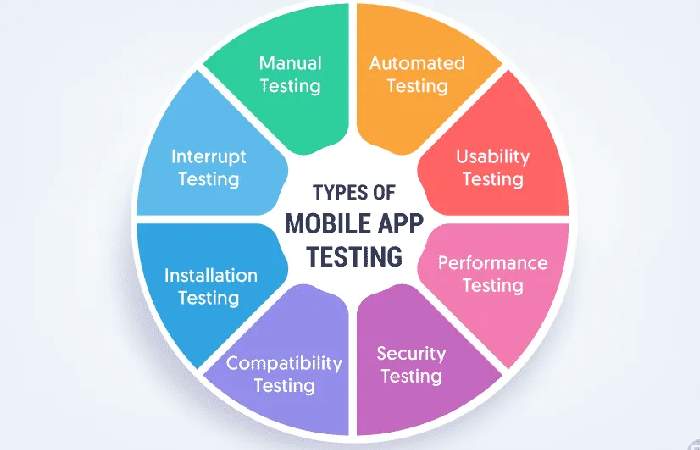In today’s fast-paced digital world, testing can be expensive and time-consuming if not handled efficiently. Therefore, guaranteeing an app’s good performance, dependability measures, and usability, and optimizing mobile app testing strategies becomes essential.
This article discusses how to optimize mobile application testing strategies for improved ROI and achieve better results. It covers understanding mobile application testing and ROI (Return on Investment) and their features. It also explains its features, why it is important, and the challenges faced.
What is mobile application testing?
Mobile application testing is the process of checking mobile apps while they are being developed. The primary purpose of mobile application testing is to test the apps for their usability, resilience, and functionality. The application is also tested from different factors including its implementation, safety, and UI.
Types of mobile application testing

The different types of mobile application testing are:
- Compatibility Testing: The primary motive of this testing is to ensure that the application functions flawlessly across several platforms, formats, and devices.
- Localization Testing: It makes an application more accessible and appealing worldwide. It ensures that the application works flawlessly when modified to various languages, and cultural preferences.
- Functional Testing: It verifies that the software program appeases user desires and expectations by examining its features and interactions function as intended.
- Performance Testing: It maintains optimal performance and assesses the app’s responsiveness, speed, and stability in routine and intense situations.
- Regression testing: Regression testing ensures that recent upgrades or modifications have not brought any new errors or problems. It also verifies that the functionality is still present, preserving the application’s dependability.
Features of mobile application testing
Some features of mobile application testing are mentioned below:
Ensures App Functionality- Mobile application testing verifies that all features, workflows, and functionalities of the app operate as intended. It ensures users can achieve their goals without interruptions. It uncovers hidden bugs or glitches that might not be apparent during development. Addressing these proactively helps maintain the app’s integrity.
Maintains Performance Standards- Mobile application testing tests whether the app uses system resources (CPU, memory, battery) optimally. It verifies the app’s ability to handle high user loads and simultaneous transactions without crashes or slowdowns. It also simulates different conditions, such as low battery, limited storage, or background app activity, to ensure reliable performance.
Validates Compatibility- With the variety of smartphones and tablets available, testing ensures the app works consistently across different hardware configurations. Mobile application testing covers various versions of Android, iOS, or other operating systems to prevent compatibility issues.
Builds Brand Reputation- A well-tested app delivers a positive user experience, which fosters user trust and brand loyalty. It prevents app store reviews from complaining about crashes, bugs, or poor performance, which can deter new users.
Reduces Costs- In mobile application testing identifying and fixing bugs during the development phase is significantly cheaper than post-launch fixes. Comprehensive testing reduces the chances of frequent patches and updates to address overlooked issues.
Verifies Network Resilience- Mobile application tests ensure the app works seamlessly under different network conditions, such as low bandwidth or switching between Wi-Fi and mobile data. It ensures critical features remain accessible even without an active internet connection. It also verifies the app’s response to scenarios like incoming calls, low network signal, or loss of connectivity.
Supports Continuous Improvement- This type of testing provides valuable feedback to developers for refining the app in future iterations. Frequent testing cycles align with agile methodologies, ensuring faster and iterative delivery of new features.
Understanding ROI
ROI or Return On Investment refers to comparing the expenses to the revenue earned for a specific campaign or service within a certain time frame. ROI serves as the mirror to showcase the results of all the efforts in developing app features, marketing, and other services.
A high ROI indicates that testing efforts are cost-effective, leading to improved app quality, faster releases, better user experience, and increased revenue. It helps organizations determine whether their testing strategies are delivering optimal value or need optimization.
Key features of ROI (Return on Investment)
Evaluating Long-Term Viability- ROI can also be used to evaluate the long-term effect of strategic investments. It enables leaders to weigh these long-term benefits against immediate costs, supporting decisions that drive future growth.
Time-Sensitive- It can be calculated for specific timeframes, such as monthly, quarterly, or annually. Time-bound ROI assessments help track progress and adjust strategies as needed.
Customizable Formula- ROI calculations can be adjusted to include direct and indirect costs or benefits. Different organizations may use customized ROI models for better accuracy.
Risk Management- Understanding ROI lets organizations evaluate the risk with different investments. It also helps organizations balance risk and reward when allocating resources.
Resource Optimization- Maximising resource efficiency is important in today’s competitive environment. ROI helps organizations identify areas where resources are best utilized. This helps ensure that investment generates the maximum benefit and helps them increase productivity.
Performance Metric- It evaluates how efficiently resources are used to achieve desired results. It helps compare different investments or projects for better decision-making.
Setting Measurable Goals- ROI gives a clear, quantifiable benchmark for success, allowing organizations to set and track performance goals. Measuring ROI at regular intervals helps organizations monitor progress, make adjustments as required, and assess effectiveness. This also helps test teams align their activities with the organization’s financial objectives, providing a results-driven culture.
Why is ROI important in mobile app testing?
ROI in automated mobile app testing is a metric that helps you understand the return you will get when implementing automation into your QA workflows. Here’s why ROI is essential in mobile application testing:
Cost justification- ROI in mobile app testing demonstrates the effectiveness of testing expenses, helping justify the budget for tools, teams, and infrastructure. It ensures efficient use of available resources by highlighting cost-effective testing practices.
Improved app quality- It ensures fewer bugs post-launch, reducing costly hotfixes and downtime.
Faster time to market (TTM)- Automation and efficient testing processes reduce testing cycles, enabling faster app launches. A shorter TTM allows organizations to stay ahead of competitors by delivering updates quickly.
User satisfaction and retention- Bug-free apps receive better reviews, improving visibility on app stores. Users are more likely to engage with apps that function well, increasing retention and loyalty.
Long-term sustainability- Early detection of issues lowers long-term maintenance expenses. A high ROI supports future investments in advanced testing technologies.
Quality assurance- Higher ROI indicates that testing efforts lead to fewer bugs, improved user experience, and better application performance.
Risk management- ROI in mobile app testing involves identifying, evaluating, and mitigating potential risks during the development and testing process. It identifies bugs early during testing, reducing costly fixes after the application is launched.
Key challenges in achieving high ROI in mobile application testing
Mentioned below are some key challenges faced in achieving high ROI in mobile application testing:
Incomplete Test Coverage
- Difficulty in covering all devices, OS versions, and screen resolutions.
- Limited testing across different network conditions.
High Testing Costs
- Investment in tools, devices, and skilled testers can be expensive.
- Maintenance of automated test scripts can add to costs.
Limited Automation Adoption
- Lack of expertise in automation frameworks.
- Difficulty in automating complex scenarios like UX and performance tests.
Time Constraints
- Pressure to release apps quickly can reduce testing time.
- Frequent updates require continuous testing within tight deadlines.
Defect Leakage to Production
- Bugs found after release can damage brand reputation.
- Fixing bugs post-launch is more costly and time-consuming.
Device Fragmentation
- The wide range of devices, platforms, and OS versions makes comprehensive testing challenging.
Inadequate Test Planning and Strategy
- The lack of a well-defined testing strategy leads to inefficient testing processes.
- Misaligned testing goals and objectives.
Lack of Skilled Resources
- Shortage of experienced testers familiar with both manual and automated testing techniques.
Testing Environment Limitations
- Inconsistent or unstable testing environments can affect test accuracy.
- Insufficient test data can limit scenario coverage.
Integration Issues
- Problems with integrating testing tools into development pipelines.
- Delays due to broken CI/CD workflows.
Changing Requirements and Scope Creep
- There are chances that frequent changes in-app features may result in the disruption of the testing process.
Strategies for Optimizing Mobile App Testing for Improved ROI
Some key strategies for optimizing mobile app testing for improved ROI are mentioned below:
Planning and Requirement Analysis- Testers can ensure that testing goals reflect organization targets like reduced time-to-market and enhanced user satisfaction. They can establish clear performance indicators like defect detection rates, test coverage, and app crash rates.
Test Automation Integration- Using automation for regression, functional, and performance testing helps to save time and reduce costs. Testers can select automation tools that fit their tech stack, such as Selenium, Appium, or LambdaTest.
Early and Continuous Testing- Testing early in the development cycle helps to catch issues sooner. Developers can implement continuous testing within CI/CD pipelines for seamless releases.
Real-Device and Cloud-Based Testing- Using real devices helps to ensure accurate results, covering various models and OS versions. Testers can leverage cross-browser platforms like LambdaTest for scalable, on-demand testing.
Lambdatest is an AI-powered test orchestration and execution platform that offers a comprehensive suite of features that optimize mobile app testing for improved ROI. It is used to test web and mobile applications manually and automated in real-time at scale. Its real-device cloud provides instant access to more than 3000 environments, real mobile devices, and browsers online, enabling seamless compatibility and cross-platform testing without maintaining in-house device labs.
Its automation capabilities through Appium, CI/CD integrations, and parallel testing reduce time-to-market and operational costs. Manual app testing includes live debugging, geolocation testing, and real-time screen recording for better bug tracking and reporting.
Performance and load testing ensure app scalability under heavy traffic, while security protocols safeguard data integrity. With smart test orchestration, test scheduling, and detailed analytics, LambdaTest simplifies testing management. Its broad integration ecosystem, actionable insights, and 24/7 expert support help organizations deliver high-quality apps efficiently, maximizing ROI.
Performance and Load Testing- Testers can use tools like JMeter and LoadRunner to detect bottlenecks before release. They can evaluate app performance under different load conditions.
Beta Testing and User Feedback- Releasing pre-launch versions to limited users helps testers gather valuable feedback. It also helps testers to continuously improve the app based on user suggestions.
Cost-Effective Resource Management- Developers and testers can consider outsourcing or using freelancers for specialized testing tasks. They can combine manual and automated testing based on complexity and criticality.
Regular Process Evaluation and Improvement- Analyzing testing performance after app launches helps optimize mobile application testing for improved ROI. Testers can continuously optimize testing strategies based on past experiences and evolving technologies.
Conclusion
Achieving high ROI in mobile application testing needs a strategic and well-planned approach that balances quality assurance with cost-effectiveness. Best practices like early testing, test automation, real-device testing, and continuous integration can help organizations reduce time-to-market, enhance app performance, and improve user satisfaction.





